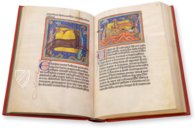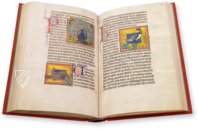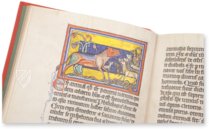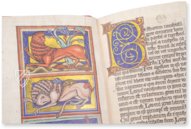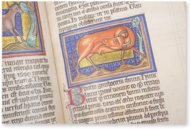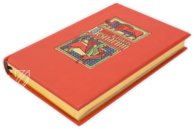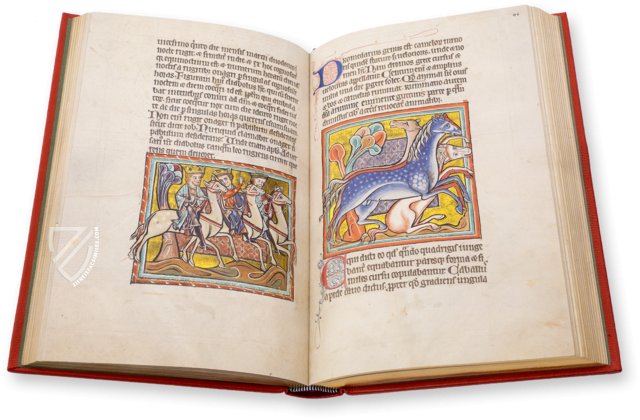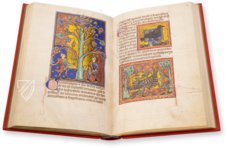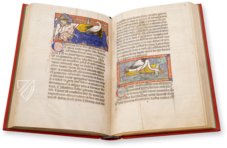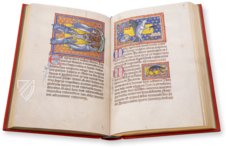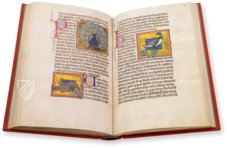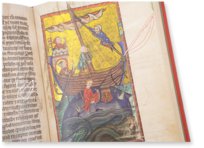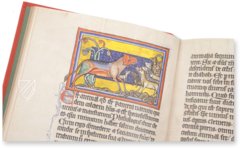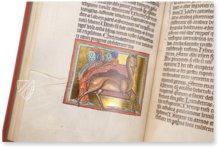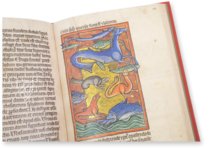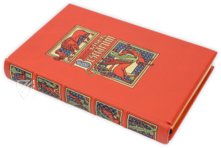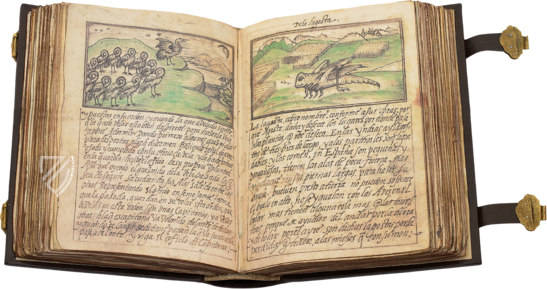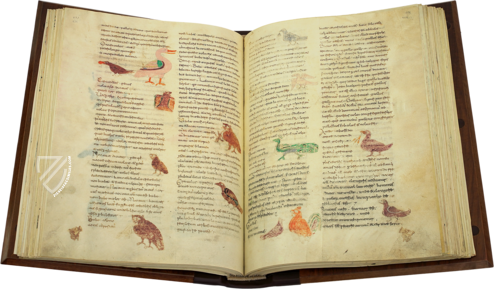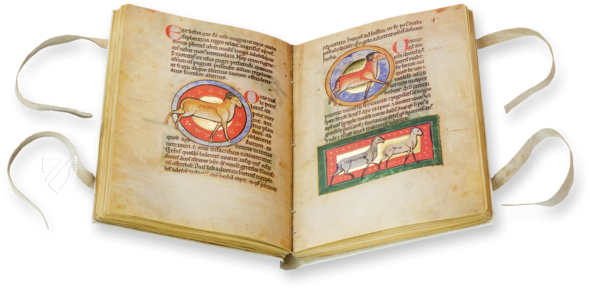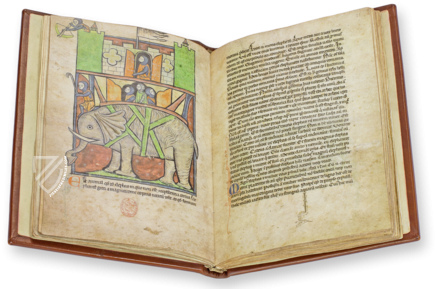Liber Bestiarum
(1,000€ - 3,000€)
The bestiary from Oxford’s Bodleian Library counts among the most beautiful of these beloved 12th and 13th century manuscripts. In 135 miniatures, numerous animals and fantasy creatures are presented. These are depicted untypically in gorgeous scenes and often even while interacting with people. Glimmering gold leaf, filigree ornamentations, and gorgeous initials round out the elegant and valuable impression of the Liber Bestiarum. An unknown master created this exceptional bestiary in the years 1243–1260 in Salisbury at the behest of the knight Roger de Mohaut.
Liber Bestiarum
The bestiary from Oxford’s Bodleian Library counts among the most beautiful of these beloved 12th and 13th century manuscripts. In 135 miniatures, numerous animals and fantasy creatures are presented. These are depicted untypically in gorgeous scenes and often even while interacting with people. Glimmering gold leaf, filigree ornamentations, and gorgeous initials round out the elegant and valuable impression of this manuscript. An unknown master created this exceptional bestiary in the years 1243–1260 in Salisbury at the behest of the knight Roger de Mohaut.
Not Merely a Simple Animal Book!
The manuscript with the shelf mark Bodley 764 of the Bodleian Library at Oxford is one of the great treasures of that library. The manuscript De animalibus is considered to be one of the most beautiful specimens of a medieval bestiary. These manuscripts were particularly widespread in England in the 12th and 13th century and enjoyed great popularity. With these bestiaries, it was not merely a matter of representing the animal kingdom in a zoological standard work of the Middle Ages, but were rather and above all concerned with the presentation of God’s creation – a religious aspect!
A Precious Commission
The Liber Bestiarum from Oxford is a 13th century work, made in Salisbury in the years 1243–1260. The patron of this manuscript was Roger de Mohaut, a noble knight. An indication of him can be found in the form an escutcheon in the miniature of the elephant. Additionally, the manuscript has other references to its later owners, Queen Isabella and her grandson, John of Gaunt, inter alia.
Gorgeous Natural Observations
The oxford bestiary collects 135 miniatures on 274 pages. Each is beautifully framed. The depictions of animals present mammals, birds, insects, fish, and fantastic creatures. The miniatures show, inter alia, a shaggy bear, who has caught something to eat, a gentle unicorn, an eagle, who sits in a burning eagle’s nest with broad wings, or a cat, who lurks toward a bird in a cage. In each case, an animal is depicted before a schematic background with floral decoration, stylized trees, and nature. Often times the animals are also depicted in their typical environment or even interacting with humans, an uncommon representation for a bestiary. This Liber Bestiarum is the work of a gifted miniaturist, who probably never saw some of the animals, e.g. the crocodile, with his own eyes, but was nonetheless able to give realistic images of them!
Codicology
- Alternative Titles
- De animalibus
Bodleian Bestiary
Book of Beasts - Size / Format
- 274 pages / 29.4 × 19.5 cm
- Origin
- United Kingdom
- Date
- 1243–1260
- Epochs
- Style
- Genre
- Language
- Script
- Gothic Textura Prescissa
- Illustrations
- 135 framed miniatures, including 4 full-pages, of animals (mammals, birds, reptiles, insects, fish, fictitious) and scenes from the daily, with the original gold leaf reproduced in foiling
- Content
- An exceptionally embellished bestiary with moralizing texts
- Patron
- Roger de Montalt / Mohaut (ca. 1200–65)
- Previous Owners
- Isabella of France, Queen of England (ca. 1295–1358)
John of Gaunt (1340–99)
Sir Thomas Bodley (1545–1613)
Book of Beasts
A Rat Saving Coins
Aside from containing powerful beasts like lions or creatures of fantasy like dragons, bestiaries also devoted space to animals as humble as the common rat. The negative association with rats that is common in western culture is largely due to their association with the 14th century plague that devastated Europe. However, images of rats saving coins were a common medieval metaphor for their stockpiling of food for the winter, not unlike the message of Aesop’s fable “The Ant and the Grasshopper”.

Book of Beasts
The Aspidochelone
The legendary aspidochelone is alternatively depicted as a whale, turtle, or a sea monster with spikes on its back. No matter its form, it is so massive that it is mistaken for an island and thus entices unwitting sailors to land on its back, at which point it pulls them down into the depths of the ocean. In the bestiary tradition, it is a moralistic allegory for Satan, who deceives those whom he seeks to devour.
Before a glimmering gold leaf background imprinted with a pattern of diamonds and flowers, sailors have anchored their ship to the back of the aspidochelone, which is camouflaged by plants. A cook has started a fire “onshore” that the creature will soon feel, causing it to dive and drag its victims down with it.

#1 Liber Bestiarum
(1,000€ - 3,000€)
- Treatises / Secular Books
- Apocalypses / Beatus
- Astronomy / Astrology
- Bestiaries
- Bibles / Gospels
- Chronicles / History / Law
- Geography / Maps
- Saints' Lives
- Islam / Oriental
- Judaism / Hebrew
- Single Leaf Collections
- Leonardo da Vinci
- Literature / Poetry
- Liturgical Manuscripts
- Medicine / Botany / Alchemy
- Music
- Mythology / Prophecies
- Psalters
- Other Religious Books
- Games / Hunting
- Private Devotion Books
- Other Genres
- Afghanistan
- Armenia
- Austria
- Belgium
- Colombia
- Croatia
- Cyprus
- Czech Republic
- Denmark
- Egypt
- Ethiopia
- France
- Germany
- Greece
- Hungary
- India
- Iran
- Iraq
- Israel
- Italy
- Japan
- Lebanon
- Luxembourg
- Mexico
- Morocco
- Netherlands
- Palestine
- Peru
- Poland
- Portugal
- Russia
- Serbia
- Spain
- Sri Lanka
- Sweden
- Switzerland
- Syria
- Turkey
- Ukraine
- United Kingdom
- United States
- Uzbekistan
- Aboca Museum
- Ajuntament de Valencia
- Akademie Verlag
- Akademische Druck- u. Verlagsanstalt (ADEVA)
- Aldo Ausilio Editore - Bottega d’Erasmo
- Alecto Historical Editions
- Alkuin Verlag
- Almqvist & Wiksell
- Amilcare Pizzi
- Andreas & Andreas Verlagsbuchhandlung
- Archa 90
- Archiv Verlag
- Archivi Edizioni
- Arnold Verlag
- ARS
- Ars Magna
- ArtCodex
- AyN Ediciones
- Azimuth Editions
- Badenia Verlag
- Bärenreiter-Verlag
- Belser Verlag
- Belser Verlag / WK Wertkontor
- Benziger Verlag
- Bernardinum Wydawnictwo
- BiblioGemma
- Biblioteca Apostolica Vaticana (Vaticanstadt, Vaticanstadt)
- Bibliotheca Palatina Faksimile Verlag
- Bibliotheca Rara
- Boydell & Brewer
- Bramante Edizioni
- Bredius Genootschap
- Brepols Publishers
- British Library
- C. Weckesser
- Caixa Catalunya
- Canesi
- CAPSA, Ars Scriptoria
- Caratzas Brothers, Publishers
- Carus Verlag
- Casamassima Libri
- Chavane Verlag
- Christian Brandstätter Verlag
- Circulo Cientifico
- Club Bibliófilo Versol
- Club du Livre
- CM Editores
- Collegium Graphicum
- Collezione Apocrifa Da Vinci
- Comissão Nacional para as Comemorações dos Descobrimentos Portugueses
- Coron Verlag
- Corvina
- CTHS
- D. S. Brewer
- Damon
- De Agostini/UTET
- De Nederlandsche Boekhandel
- De Schutter
- Deuschle & Stemmle
- Deutscher Verlag für Kunstwissenschaft
- DIAMM
- Droz
- E. Schreiber Graphische Kunstanstalten
- Ediciones Boreal
- Ediciones Grial
- Ediclube
- Edições Inapa
- Edilan
- Editalia
- Edition Deuschle
- Edition Georg Popp
- Edition Leipzig
- Edition Libri Illustri
- Editiones Reales Sitios S. L.
- Éditions de l'Oiseau Lyre
- Editions Medicina Rara
- Editorial Casariego
- Editorial Mintzoa
- Editrice Antenore
- Editrice Velar
- Edizioni Edison
- Egeria, S.L.
- Eikon Editores
- Electa
- Emery Walker Limited
- Enciclopèdia Catalana
- Eos-Verlag
- Ephesus Publishing
- Ernst Battenberg
- Eugrammia Press
- Extraordinary Editions
- Fackelverlag
- Facsimila Art & Edition
- Facsimile Editions Ltd.
- Facsimilia Art & Edition Ebert KG
- Faksimile Verlag
- Feuermann Verlag
- Folger Shakespeare Library
- Franco Cosimo Panini Editore
- Friedrich Wittig Verlag
- Fundación Hullera Vasco-Leonesa
- G. Braziller
- Gabriele Mazzotta Editore
- Gebr. Mann Verlag
- Gesellschaft für graphische Industrie
- Getty Research Institute
- Giovanni Domenico de Rossi
- Giunti Editore
- Graffiti
- Grafica European Center of Fine Arts
- Guido Pressler
- Guillermo Blazquez
- Gustav Kiepenheuer
- H. N. Abrams
- Harrassowitz
- Helikon
- Hendrickson Publishers
- Henning Oppermann
- Herder Verlag
- Hes & De Graaf Publishers
- Hoepli
- Holbein-Verlag
- Hortus Deliciarum
- Houghton Library
- Hugo Schmidt Verlag
- Idion Verlag
- Il Bulino, edizioni d'arte
- ILte
- Imago
- Insel Verlag
- Instituto Nacional de Antropología e Historia
- Istituto dell'Enciclopedia Italiana - Treccani
- Istituto Ellenico di Studi Bizantini e Postbizantini
- Istituto Geografico De Agostini
- Istituto Poligrafico e Zecca dello Stato
- Italarte Art Establishments
- J. Thorbecke
- Jan Thorbecke Verlag
- Johnson Reprint Corporation
- Josef Stocker
- Josef Stocker-Schmid
- Jugoslavija
- Karl W. Hiersemann
- Kasper Straube
- Kaydeda Ediciones
- Kindler Verlag / Coron Verlag
- Kodansha International Ltd.
- Konrad Kölbl Verlag
- Kurt Wolff Verlag
- La Liberia dello Stato
- La Linea Editrice
- La Meta Editore
- Lambert Schneider
- Landeskreditbank Baden-Württemberg
- Leo S. Olschki
- Les Incunables
- Library of Congress
- Libreria Musicale Italiana
- Lichtdruck
- Lito Immagine Editore
- Lumen Artis
- Lund Humphries
- M. Moleiro Editor
- Maison des Sciences de l'homme et de la société de Poitiers
- Manuscriptum
- Martinus Nijhoff
- Maruzen-Yushodo Co. Ltd.
- MASA
- McGraw-Hill
- Militos
- Millennium Liber
- Müller & Schindler
- Nahar and Steimatzky
- National Library of Wales
- Neri Pozza
- Nova Charta
- Oceanum Verlag
- Odeon
- Orbis Mediaevalis
- Orbis Pictus
- Österreichische Staatsdruckerei
- Oxford University Press
- Pageant Books
- Parzellers Buchverlag
- Patrimonio Ediciones
- Pattloch Verlag
- PIAF
- Pieper Verlag
- Plon-Nourrit et cie
- Prestel Verlag
- Princeton University Press
- Prisma Verlag
- Priuli & Verlucca, editori
- Pro Sport Verlag
- Propyläen Verlag
- Pytheas Books
- Quaternio Verlag Luzern
- Reales Sitios
- Recht-Verlag
- Reichert Verlag
- Reichsdruckerei
- Riehn & Reusch
- Roberto Vattori Editore
- Rosenkilde and Bagger
- Roxburghe Club
- Salerno Editrice
- Sarajevo Svjetlost
- Schöck ArtPrint Kft.
- Scolar Press
- Scrinium
- Scripta Maneant
- Scriptorium
- Siloé, arte y bibliofilia
- SISMEL - Edizioni del Galluzzo
- Sociedad Mexicana de Antropología
- Société des Bibliophiles & Iconophiles de Belgique
- Soncin Publishing
- Sorli Ediciones
- Stainer and Bell
- Studer
- Styria Verlag
- Sumptibus Pragopress
- Szegedi Tudomànyegyetem
- Taberna Libraria
- Tarshish Books
- Taschen
- Tempus Libri
- Testimonio Compañía Editorial
- Thames and Hudson
- The Clear Vue Publishing Partnership Limited
- The Facsimile Codex
- The Folio Society
- The Marquess of Normanby
- The Richard III and Yorkist History Trust
- Tip.Le.Co
- TouchArt
- TREC Publishing House
- TRI Publishing Co.
- Trident Editore
- Typis Regiae Officinae Polygraphicae
- Union Verlag Berlin
- Universidad de Granada
- University of California Press
- University of Chicago Press
- Urs Graf
- Vallecchi
- Van Wijnen
- VCH, Acta Humaniora
- VDI Verlag
- VEB Deutscher Verlag für Musik
- Verlag Anton Pustet / Andreas Verlag
- Verlag Bibliophile Drucke Josef Stocker
- Verlag der Münchner Drucke
- Verlag für Regionalgeschichte
- Verlag Styria
- Vicent Garcia Editores
- W. Turnowsky
- Waanders Printers
- Wiener Mechitharisten-Congregation (Wien, Österreich)
- Wissenschaftliche Buchgesellschaft
- Wydawnictwo Dolnoslaskie
- Xuntanza Editorial
- Zakład Narodowy
- Zollikofer AG








